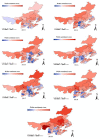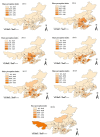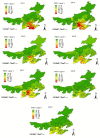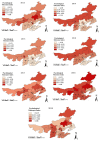Quantitative Evaluation of Psychological Tolerance under the Haze: A Case Study of Typical Provinces and Cities in China with Severe Haze
- PMID: 35682158
- PMCID: PMC9180424
- DOI: 10.3390/ijerph19116574
Quantitative Evaluation of Psychological Tolerance under the Haze: A Case Study of Typical Provinces and Cities in China with Severe Haze
Abstract
The interplay of specific weather conditions and human activity results due to haze. When the haze arrives, individuals will use microblogs to communicate their concerns and feelings. It will be easier for municipal administrators to alter public communication and resource allocation under the haze if we can master the emotions of netizens. Psychological tolerance is the ability to cope with and adjust to psychological stress and unpleasant emotions brought on by adversity, and it can guide human conduct to some extent. Although haze has a significant impact on human health, environment, transportation, and other factors, its impact on human mental health is concealed, indirect, and frequently underestimated. In this study, psychological tolerance was developed as a psychological impact evaluation index to quantify the impact of haze on human mental health. To begin, data from microblogs in China's significantly haze-affected districts were collected from 2013 to 2019. The emotion score was then calculated using SnowNLP, and the subject index was calculated using the co-word network approach, both of which were used as social media evaluation indicators. Finally, utilizing ecological and socioeconomic factors, psychological tolerance was assessed at the provincial and prefecture level. The findings suggest that psychological tolerance differs greatly between areas. Psychological tolerance has a spatio-temporal trajectory in the timeseries as well. The findings offer a fresh viewpoint on haze's mental effects.
Keywords: haze perception; psychological tolerance level; quantitative evaluation; sentiment analysis; spatio-temporal trajectory.
Conflict of interest statement
The authors have no conflict of interest.
Figures










References
-
- Tan J., Duan J., Chen D., Wang X., Bi X., Fu J. Chemical characteristics of haze during summer and winter in Guangzhou—ScienceDirect. Atmos. Res. 2009;94:238–245. doi: 10.1016/j.atmosres.2009.05.016. - DOI
-
- Huang J., Mcqueen J., Wilczak J., Djalalova I., Stajner I., Shafran P., Delle M.L. Improving NOAA NAQFC PM2.5 Predictions with a Bias Correction Approach. Weather Forecast. 2017;32:407–421. doi: 10.1175/WAF-D-16-0118.1. - DOI
-
- Krzyzanowski M. In: Health Effects of Transport-Related Air Pollution. Krzyzanowski M., Kuna-Dibbert B., Schneider J., editors. Volume 97. WHO Regional Office Europe; Copenhagen, Denmark: 2005. pp. 418–419.
-
- Zhang J., Guo C., Xu H., Li Y., Zhang L., Dong C., Shi Y., Qian H., Jin Q. Time series study on the relationship between air pollution and outpatient volume of respiratory diseases in a hospital in Shanghai. Environ. Occup. Med. 2014;31:846–851.
Publication types
MeSH terms
Substances
LinkOut - more resources
Full Text Sources
Medical

